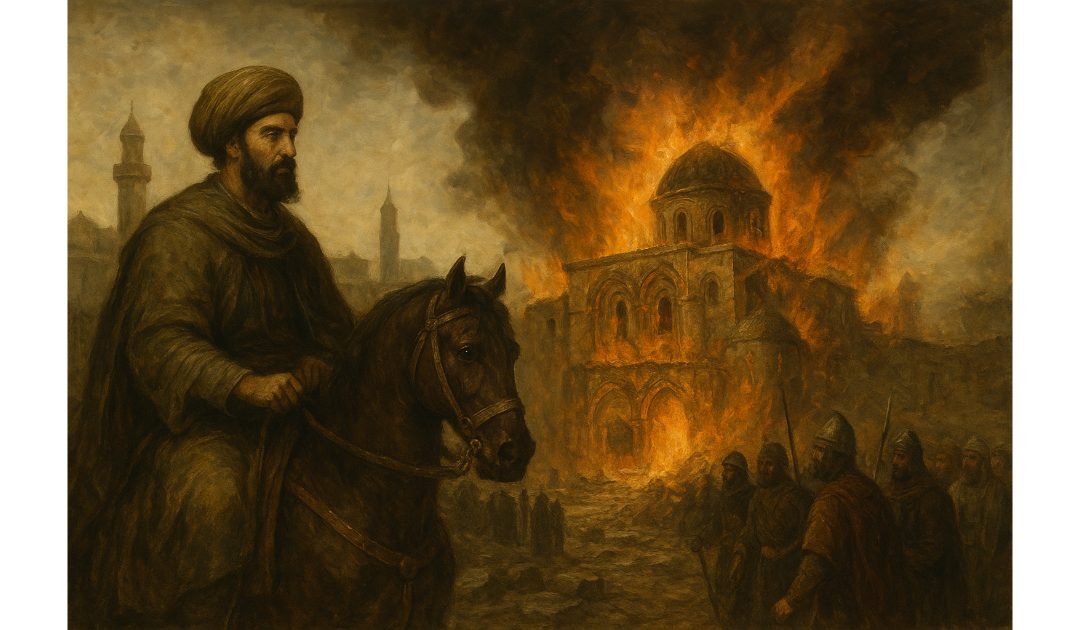On the 18th of October, 1009, the Church of the Holy Sepulchre in Jerusalem was completely destroyed by Fatimid caliph Al Hakim bi Amr Allah, who hacked the church’s foundations down to the bedrock.
The Church of the Holy Sepulchre, located in the Christian Quarter of the Old City of Jerusalem, is one of the most venerated sites in Christianity. It is traditionally believed to encompass both the location of Jesus Christ’s crucifixion, known as Golgotha or Calvary, and his tomb, where he was buried and subsequently resurrected. The church’s history is a tapestry woven with religious significance, architectural evolution, and the vicissitudes of political and military upheavals.
The Church of the Holy Sepulchre was commissioned by Emperor Constantine the Great in the early 4th century CE following the Edict of Milan in 313 CE, which legalised Christianity within the Roman Empire. Constantine’s mother, Helena, played a pivotal role in identifying the site during her pilgrimage to Jerusalem around 326 CE. According to tradition, she discovered the True Cross, the very cross upon which Jesus was crucified, during excavations that she directed.
Construction began soon afterwards, with the church being consecrated in 335 CE. The structure was grand, encompassing a large basilica (the Martyrium), an open courtyard (the Triportico), and a rotunda housing the Edicule, the small shrine enclosing the burial site of Jesus. This complex set a precedent for Christian sacred architecture.
Over the centuries, the Church of the Holy Sepulchre endured numerous cycles of destruction and restoration, each reflecting the tumultuous history of Jerusalem. In 614 CE, the city fell to the Sasanian Empire under King Khosrow II, who partially destroyed the church. The Byzantine Emperor Heraclius managed to restore it after reclaiming Jerusalem in 629 CE.
The advent of Islamic rule in 638 CE saw Caliph Umar ibn al-Khattab recognising the church’s importance. He granted protection to Christian sites, allowing the continued practice of Christianity. However, in 1009 CE, the church suffered catastrophic damage when the Fatimid Caliph Al-Hakim bi-Amr Allah ordered its demolition. This act strained relations between the Islamic world and Christian Europe, contributing to the motivations behind the Crusades.
The First Crusade, launched at the end of the 11th century, culminated in the capture of Jerusalem in 1099. The Crusaders undertook extensive reconstruction of the Church of the Holy Sepulchre, completing it in 1149 to commemorate the 50th anniversary of their conquest. The Crusader church incorporated Romanesque architectural styles, blending elements from earlier structures with new designs.
This period also established the complex system of custodianship that persists today. Different Christian denominations, including the Greek Orthodox, Armenian Apostolic, and Roman Catholic Churches, began sharing responsibilities for the church’s various chapels and altars.
Following the fall of Jerusalem to Saladin in 1187, the Church of the Holy Sepulchre remained under Muslim control, but Christian pilgrims were generally allowed access. Under Ottoman rule from the 16th century, the “Status Quo” arrangement was formalised in the 19th century, delineating the rights and responsibilities of the various Christian communities within the church. This agreement, which remains in effect today, dictates the intricate schedule of ceremonies and the maintenance of specific areas.
In the 20th and 21st centuries, the Church of the Holy Sepulchre has continued to be a focal point for Christian pilgrimage. Restoration efforts have aimed to preserve its structural integrity while respecting the delicate balance of custodial authority. A significant restoration of the Edicule was completed in 2017, revealing parts of the original rock surface believed to be the burial bed of Jesus.
The Church of the Holy Sepulchre is a place of worship. It hosts daily liturgical services conducted by the different denominations, each following their ancient rites. The church is central to the observance of Holy Week, particularly during Good Friday and Easter Sunday ceremonies, attracting thousands of pilgrims from around the world.
Pilgrims and visitors often express awe at the church’s layered history, visible in its varied architectural styles and the palpable sense of reverence. The Stone of Anointing, where Jesus’ body is believed to have been prepared for burial, and the Aedicule itself are focal points of devotion.
I’m not a great fan of organised religions, they seem to cause as much death and destruction as they prevent. Yet I am a pilgrim, I have the piece of paper to prove it, and my feet have never been quite the same since. I do want to visit Jerusalem one day, but it looks like I might have to wait a while.

